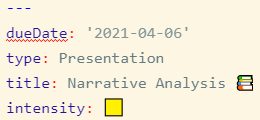I actually hadn’t figured it out myself, but your question made me give it a go. I think I’ve got it…
So, I’m gonna use an example:
In each of my assignments, I have a field (intensity) with a red, yellow, or green square telling me how much work will be required.

So, if I want to group all of my assignments by their intensity, I do the following.
First, gather all the assignments:
FROM #Assignments
Then, group by intensity:
GROUP BY intensity
rows Object
Now, here is the part that confused me… by grouping them, you’ve now got a new object created by the grouping. This is a nested list of all the assignments grouped by intensity. So something like:
[
[A1, A2, A6], // Green
[A3, A4], // Yellow
[A5, A7] // Red
]
The way you access this new list is with the rows object.
So if I want the file name of every note in the array, I call rows.file.name.
If I want the dueDate of each note in the array, I call rows.dueDate.
In this example, I call the title property (rows.title).
Now, you sorta have to change the ordering around, but it should still make sense.
TABLE intensity, rows.title
FROM #Assignment
GROUP BY intensity
Which gives me this, as desired:
So for your example, you want to group files by subtag. Can you try this and let me know what you get? I think the output will be a little messy, because it repeats alot of the tags, but it should still group them as you want.
TABLE rows.file.name, rows.file.tags
FROM #Note
GROUP BY file.tags
Also, it will only consider two notes to be in the same group if they have exactly the same tags. So even if two notes have #Note/Author, if the one has a tag that the other doesn’t, I don’t think they’ll be grouped together.
